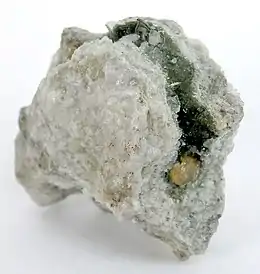Humite
Humite is a mineral found in the volcanically ejected masses of Vesuvius. It was first described in 1813 and named for Abraham Hume (1749–1838).[4]
| Humite | |
|---|---|
 Humite specimen, Italy | |
| General | |
| Category | Nesosilicates |
| Formula (repeating unit) | (Mg,Fe)7(SiO4)3(F,OH)2. |
| Strunz classification | 9.AF.50 |
| Crystal system | Orthorhombic |
| Crystal class | Dipyramidal (mmm) H–M Symbol: (2/m 2/m 2/m) |
| Space group | Pbnm |
| Unit cell | a = 10.24, b = 20.72 c = 4.73 [Å]; Z = 4 |
| Identification | |
| Color | White, yellow, dark orange, brown |
| Cleavage | Poor |
| Fracture | Uneven to subconchoidal |
| Tenacity | Brittle |
| Mohs scale hardness | 6–6.5 |
| Luster | Vitreous |
| Streak | White |
| Diaphaneity | Transparent |
| Specific gravity | 3.20 – 3.32 |
| Optical properties | Biaxial (+) |
| Refractive index | nα =1.607-1.643, nβ=1.619-1.653, nγ=1.639-1.675 |
| Birefringence | 0.0320 |
| 2V angle | Calculated = 70-78°, measured = 68-81° |
| Dispersion | Weak, r > v |
| References | [1][2][3] |
See also
References
- Handbook of Mineralogy
- Webmineral data
- Mindat w/ locations
- Deer, W.; Howie, R.; Zussman, J. (1997). Rock-forming Minerals: Volume 1A, Second Edition, Orthosilicates. Bath, UK: The Geological Society. ISBN 1-897799-88-8.
External links
![]() Media related to Humite at Wikimedia Commons
Media related to Humite at Wikimedia Commons
This article is issued from Wikipedia. The text is licensed under Creative Commons - Attribution - Sharealike. Additional terms may apply for the media files.